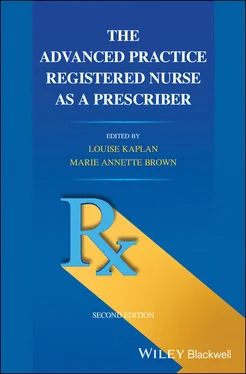Louise Kaplan and Marie Annette Brown
1 What Do APRN Prescribers Need to Understand?
Louise Kaplan and Marie Annette Brown
Today’s healthcare transformations herald unprecedented opportunities for advanced practice registered nurses (APRNs) to provide and model patient‐centered, evidence‐based healthcare. As APRNs across the country increasingly secure full practice authority, they must seize the opportunity to become pacesetters for ethical, rational, and responsible prescribing. The vast majority of APRNs (nurse practitioners, nurse midwives, nurse anesthetists, and clinical nurse specialists) work with prescription medications on a daily basis. Many are unable to imagine a practice that does not include the ability to prescribe, provide, and/or manage medications for at least some of their patients. A goal of most APRNs, however, is utilization of a wide range of therapeutic modalities in the process of patient‐centered care. This may include, but is not focused solely, on medications. Health promotion and disease prevention continue to be a hallmark of APRN practice.
At the same time, as the demand for prescriptive medications increases, prescriptive authority becomes an even more vital component of APRN practice. The number of prescriptions dispensed in 2018 was 5.8 billion, an increase of 2.7% from the prior year. During the same one‐year period, opioid prescription use decreased by 17.1% (The IQVIA Institute, 2019). In order to appropriately meet the prescribing needs of patients, APRNs must have unencumbered, full prescriptive authority and practice.
Practice in today’s complex, fast‐paced healthcare delivery system in which there is a constant barrage of information can be overwhelming. Selection and monitoring of medication appropriate for patients is only one aspect of the complex process of prescribing. This book serves as an easily accessible reference to guide practicing APRNs through these challenges and supplements pharmacotherapeutic knowledge about specific medications. APRN students can also benefit from the content of this book. Standards for APRN programs specify a pharmacotherapeutic course as well as analysis of the APRN role (National Organization of Nurse Practitioner Faculties [NONPF], 2016). Educators must focus on teaching the essential knowledge about pharmacokinetics, pharmacodynamics, and evidence‐based drug treatment recommendations. Consequently, an in‐depth discussion of the APRN’s role as a prescriber is not usually found in the curriculum. The information included in this book has been compiled by experts to facilitate this discussion. The authors have used their clinical and professional experience to synthesize and organize key ideas on a wide variety of subjects. These include:
What it means to be a prescriber
The many facets of the prescriber role
The legal, regulatory, and ethical responsibilities of APRNs who prescribe medications
Who is a prescriber globally
Managing difficult patient situations
Strategies for assessing and addressing special considerations with controlled substances
Authorizing medical marijuana
THE JOURNEY OF APRN PRESCRIPTIVE AUTHORITY
For decades, APRNs have invested innumerable hours in lobbying and regulatory work to advance APRN practice. They have solidified the APRN role, strengthened the foundation for APRN education, and expanded the knowledge base for expert practice. In the United States, APRNs in Idaho were the first authorized to prescribe medication in 1971, though it took six years for rules to be written and prescriptive authority to be implemented. Most, but not all, APRNs have now been granted prescriptive authority in all states. In California, for example, clinical nurse specialists and nurse anesthetists do not have prescriptive authority (Phillips, 2020). APRNs have repeatedly demonstrated that they provide effective, high‐quality care, including prescribing medications. Nonetheless, APRNs in over half of the United States confront prescribing barriers imposed by state law on a daily basis. These barriers include requirements for supervision or collaboration, restrictions on prescribing controlled substances, and limitations on the type and quantity of medications that can be prescribed. Other barriers are imposed by federal law, such as the conditions under which an APRN may prescribe buprenorphine for substance use disorder.
As a consequence of prescribing barriers, many APRNs are unable to practice to the full extent of their educational preparation, knowledge, and abilities. This negatively affects patient care and the healthcare system overall. Practice constraints handicap the APRN who is unable to fulfill roles in outpatient and inpatient settings. These restrictions continue despite an increased demand for primary, specialty, and acute care providers, and the integration of primary care practices into large health systems. APRNs are in more demand with shortages of primary care providers, particularly to work with the underserved and as those living in rural areas increase. Nurses have a rich history of dedication to social justice and service to marginalized communities. Successful implementation of healthcare reforms in the years to come requires APRNs to be full partners with other health professionals, which necessitates the removal of barriers to allow APRNs to practice to the full extent of their education and expertise.
Washington State as an exemplar
A legislature must pass a bill to enable any changes in the scope of practice for ARPNs. The law typically cannot be implemented until the Board of Nursing adopts rules that specify the intent of the law. Scope of practice changes can take months to years to finalize. The history of APRN prescribing in Washington State begins with a 1977 law that authorized APRNs to prescribe legend drugs (medications requiring a prescription). However, dispensing medications and prescribing controlled substances were prohibited. The Board of Nursing then wrote rules that authorized APRNs to prescribe Schedule V drugs in 1982 and dispensing was added in 1983. It was not until 2000, after more than a decade of lobbying, that APRNs in Washington State obtained Schedule II–IV prescriptive authority.
This long‐sought authority came with a price. For the first time since APRN practice was authorized by the legislature in 1973, physician involvement in APRN practice was mandated. APRNs who wanted II–IV prescriptive authority were required to obtain a Joint Practice Agreement (JPA) with a physician. Slowly over the next four years many APRNs began obtaining Schedule II–IV prescriptive authority. However, until the JPA was removed, over one‐third of APRNs chose not to obtain II–IV prescriptive authority. This contradicted the expectation of APRN leaders in the state that nearly all APRNs would want the legal ability to prescribe controlled substances even if it was only utilized occasionally. We conducted research in Washington State to understand this unexpected phenomenon (Kaplan & Brown, 2004, 2007, 2009; Kaplan et al., 2006, 2010).
The findings of our research serve as a basis of understanding how APRNs may or may not transition to full prescriptive authority and practice when provided the opportunity. It also offers lessons learned about the need to prepare APRNs for a major transition in scope of practice. Change may cause concern for some who have adapted to the status quo, even if prescribing barriers limited their ability to practice. Many of these findings are discussed in Chapter 3. They will enhance your understanding about APRN prescribing practice, the consequences of limiting APRN practice, and the poorly understood experience of transition to a new scope of practice. It is not surprising, however, that APRNs respond to new practice authority with the natural ambivalence that accompanies most change processes.
Читать дальше












